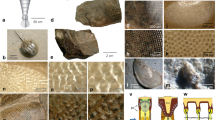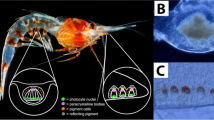Abstract
Rimicaris exoculata1 is a shrimp that swarms over high-temperature (350 °C) sulphide chimneys at Mid-Atlantic Ridge hydrothermal fields (3,600 m)1–7. This shrimp lacks an externally differentiated eye1, having instead a pair of large organs within the cephalothorax immediately beneath the dorsal surface of the transparent carapace, connected by large nerve tracts to the supraesophageal ganglion. These organs contain a visual pigment with an absorption spectrum characteristic of rhodopsin. Ultra-structural evidence for degraded rhabdomeral material suggests the presence of photoreceptors. No image-forming optics are associated with the organs. We interpret these organs as being eyes adapted for detection of low-level illumination and suggest that they evolved in response to a source of radiation associated with the environment of hydrothermal vents.
This is a preview of subscription content, access via your institution
Access options
Subscribe to this journal
Receive 51 print issues and online access
$199.00 per year
only $3.90 per issue
Buy this article
- Purchase on Springer Link
- Instant access to full article PDF
Prices may be subject to local taxes which are calculated during checkout
Similar content being viewed by others
References
Williams, A. B. & Rona, P. A. J. Crust. Biol. 6, 446–462 (1986).
Rona, P. A. EOS Trans. Am. geophys. Un. 66, 936 (1985).
Rona, P. A., Klinkhammer, G., Nelson, T. A., Trefry, J. H. & Elderfield, H. Nature 321, 33–37 (1986).
Grassle, J. F., Humphris, S. E., Rona, P. A., Thompson, G. & Van Dover, C. L. EOS Trans. Am. geophys. Un. 67, 1022 (1986).
Detrick, R. S. et al. Nature 321, 14–15 (1986).
Detrick, R. S. et al Geology 14, 1004–1007 (1986).
Van Dover, C. L., Fry, B., Grassle, J. F., Humphris, S. E. & Rona, P. A. Mar. Biol. 98, 209–216 (1988).
Bullock, T. H. & Horridge, G. A. Structure and Function in the Nervous Systems of Invertebrates (San Francisco, 1965).
Loew, E. R. Proc. R. Soc. 193, 31–44 (1976).
Meyer Rochow, V. B. Proc. R. Soc. 212, 93–111 (1981).
Nilsson, H. L. & Lindstrom, M. J. exp. Biol. 107, 277–292 (1983).
Chamberlain, S. C., Meyer-Rochow, V. B. & Dossert, W. P. J. Morph. 189, 145–156 (1986).
White, R. H. J. exp. Zool. 169, 261–278 (1968).
Blest, A. D. Proc. R. Soc. 200, 463–483 (1978).
Chamberlain, S. C. & Barlow, R. B. Jr. Science 206, 361–363 (1979).
Nassel, D. R. & Waterman, T. H. J. comp Physiol 131, 205–216 (1979).
Hubbard, R., Brown, P. K. & Bownds, D. Meth. Enzym. 18, 615–653 (1971).
Denys, C. J. & Brown, P. K. J. gen. Physiol. 82, 451–472 (1982).
Wald, G. Nature 215, 1131–1133 (1967).
Hubbard, R. & Wald, G. Nature 186, 212–215 (1960).
Hiller Adams, P., Widder, E. A. & Case, J. F. J. comp. Physiol. 163, 63–72 (1988).
Frank, T. M. & Case, J. F. Biol. Bull. 175, 261–273 (1988).
Bradner, H. et al. Deep Sea Res. 34, 1831–1840 (1987).
Pelli, D. & Chamberlain, S. C. Nature 337, 460–461 (1989).
Van Dover, C. L., Delaney, J., Smith, M., Cann, J. R. & Foster, D. Nature (submitted).
DiPolo, R. J. gen. Physiol. 62, 575–589 (1973).
Hara, T. & Hara, R. In Handbook of Sensory Physiology Vol. VII/1. (ed Dartnall, H. J. A. ) 720–746 (Springer, Berlin and New York, 1972).
Author information
Authors and Affiliations
Rights and permissions
About this article
Cite this article
Dover, C., Szuts, E., Chamberlain, S. et al. A novel eye in 'eyeless' shrimp from hydrothermal vents of the Mid-Atlantic Ridge. Nature 337, 458–460 (1989). https://doi.org/10.1038/337458a0
Received:
Accepted:
Issue Date:
DOI: https://doi.org/10.1038/337458a0
This article is cited by
-
Eyes of differing colors in Alvinocaris longirostris from deep-sea chemosynthetic ecosystems: genetic and molecular evidence of its formation mechanism
Journal of Oceanology and Limnology (2021)
-
Forty years of fathoming life in hot springs on the ocean floor
Nature (2019)
-
Sensing deep extreme environments: the receptor cell types, brain centers, and multi-layer neural packaging of hydrothermal vent endemic worms
Frontiers in Zoology (2014)
-
Hydrothermal vent fields and chemosynthetic biota on the world's deepest seafloor spreading centre
Nature Communications (2012)
-
Exceptional Variation on a Common Theme: The Evolution of Crustacean Compound Eyes
Evolution: Education and Outreach (2008)
Comments
By submitting a comment you agree to abide by our Terms and Community Guidelines. If you find something abusive or that does not comply with our terms or guidelines please flag it as inappropriate.



